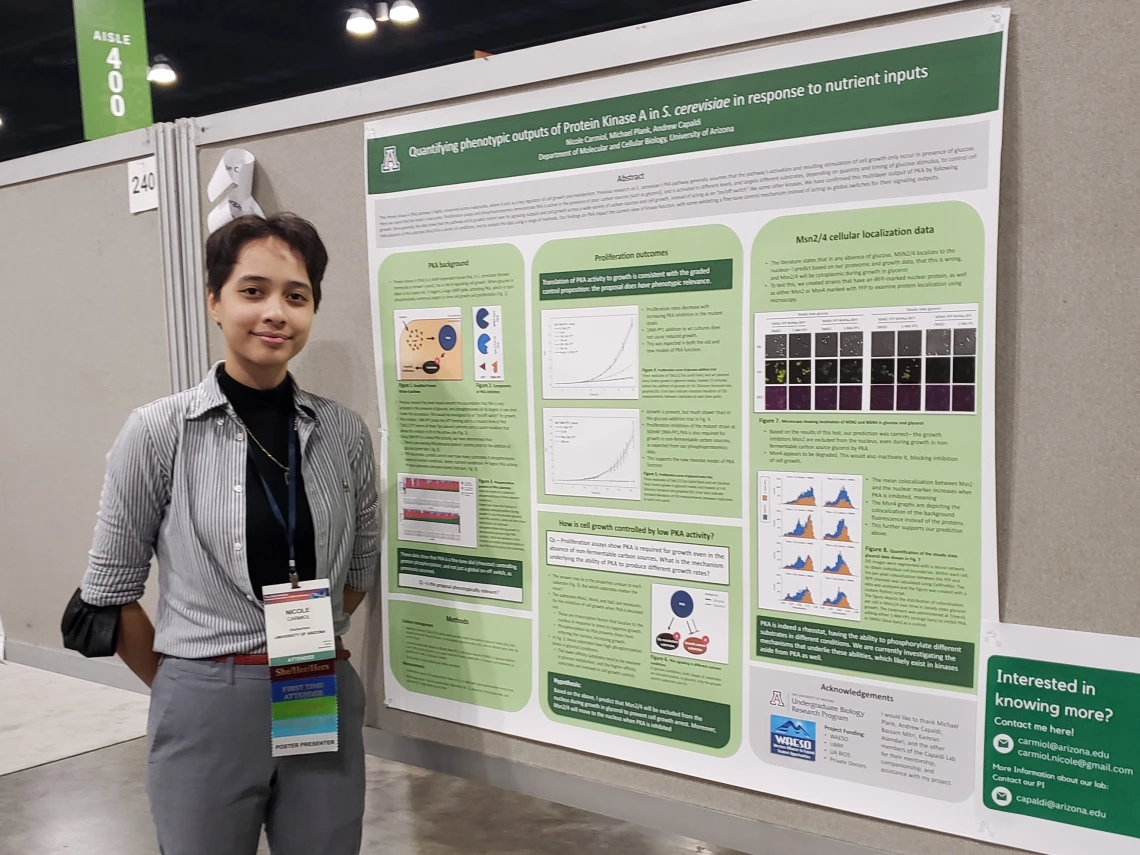Feeling At Home in Puerto Rico: An Undergrad’s Experience at SACNAS

This October I had the incredible opportunity to attend the 2022 SACNAS National Diversity in STEM Conference in San Juan, Puerto Rico. This city is known for its lively Boricua culture, and truly lively this conference was! There was music, dancing, cultural celebrations, indigenous marketplaces, local food, and many other features that made it a great time.
Besides the fun of it all, this was my first time attending a national conference and it was a more valuable experience than I predicted. I was able to present a poster on the research I’ve been working on in the Capaldi Lab. I spoke about a cell signaling system called the Protein Kinase A (PKA) pathway. We’re studying it in yeast, but the PKA pathway is highly conserved all the way up to humans. It’s currently understood that kinases are a protein in cells that can be thought of as “light switches”: they turn other things in the cell either on or off, creating a specific cellular response to a specific stimulus.
What we’ve found in the Capaldi Lab is that this light switch model for kinases may not be entirely accurate. It’s actually less like a switch, and more like a dial/rheostat, where you can finely control the level of cellular response, which changes with different stimuli. This is fascinating, especially since the PKA protein is functionally simple. How is an uncomplicated protein able to integrate complex information, and produce the appropriate output as a result? Finding this mechanism is the main goal of our current research, and this is likely not isolated to yeast, or even to PKA. This may eventually inform fields like cancer research, neural development, disease mechanisms, drug targets, since kinases are so prevalent in biology.
Interestingly enough, I noticed that the value of presenting at this conference wasn’t just in demonstrating my research. My poster became the perfect avenue to start conversations with like-minded people. I had fantastic discussions, and the opportunity to expand my worldview in these scientific settings is something that I’ve come to appreciate.
What’s special about this conference though, is that few STEM environments in the past have made me feel so “at home”. SACNAS strongly emphasizes that people should “bring your whole self”, in order to achieve their core goal of true diversity in STEM. Despite being someone who agrees with the sentiment, I didn’t fully grasp the depth of the phrase until I was able to experience a community that truly embodies it. I spoke with incredible peers and professors alike, producing some of the most enriching conversations I’ve had to date.
I was able to make some connections, and together we explored the city after the conference. We discussed our career plans as we walked the streets of Old San Juan, exchanged our home country’s traditions while strolling along the walls of a coastside castle, and even argued whose research field was superior as we sampled local street food. These people put their scientific passions and their cultural identities on the same pedestal where they intertwine and relate, creating rich perspectives with grand potential. It’s a mindset that I’m now determined to carry with me into the future.
Despite a graduate student declaring I would be exiled from the Capaldi lab if I came back without a presentation award, I returned to Tucson with a great experience. Going to a multidisciplinary conference like this is something I’d recommend to anyone. It’s not unlike the annual UBRP conference that you might already have some experience with! Whether you present a poster, or even just to experience the program, I guarantee you will leave there feeling like your brain has expanded a couple notches.
I want to thank UBRP, the BIO5 Institute, Dr. Andrew Capaldi, and the rest of the Capaldi Lab (except for the aforementioned graduate student) for assisting me with the funds and supporting me in attending this conference.




